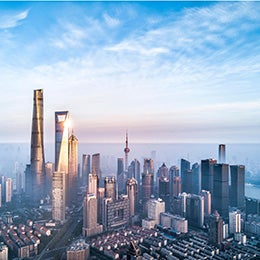
Key takeaways from our 2026 annual investment outlook webinar
Experts from equities, fixed income, real estate, alternatives, and more discuss where they see opportunities and risks in 2026.
This fund is for DC investors only. Its structure seeks to deliver daily liquidity whilst seeking to avoid the fund suspension challenges associated with UK property funds.
With 95% of investible real estate lying outside the UK, it makes sense to take advantage of the wider opportunities a global real estate approach offers.
Our investment methodology involves studying how human behaviour evolves and what this means for real estate – from demographic shifts to the rise of technology.
Historically, buildings with strong environmental, social and governance credentials are more likely to outperform.*
Invesco Real Estate owns a large number of medical offices in the US, including twenty properties in the “Sunbelt region” of Dallas, San Antonio, Nashville, Denver, Los Angeles, Tampa, and South Florida, as well as nineteen properties across twelve markets in the Caddis portfolio. These properties are located adjacent to hospital campuses in prominent metro areas, creating strong locational demand among tenants.
This demand is expected to grow over time due to changing demographics in the US. In the next 20 years, the number of Americans aged 75 and older will expand by over 20 million, more than doubling in size. Accordingly, healthcare spending in the US, which already represents nearly 18% of GDP, will only increase further. This, combined with the country’s privately funded healthcare model, creates a compelling opportunity for real estate investors.
At Invesco Real Estate, we closely monitor how people around the world consume, live, innovate, and connect with one another. Factors such as demographic shifts, climate change, and technological advances significantly impact how we use and invest in real estate.
The demand for housing in the US remains high, particularly as the population ages and centralizes in residential communities. For real estate investors, this has created a sustainable, long-term investment opportunity.
Investing in Longview (Portland MSA), WA
The tranquil suburb located just north of Portland comprises 130 sites and is 100% occupied. The community is conveniently located near highways and essential services. The average household income within a 1-mile radius is $133K, translating to an 11% rent-to-income ratio.
This high-quality, 4-star, age-restricted manufactured housing community was sourced by Invesco Real Estate in mid-2024 off-market in a strong suburban Portland submarket with stable growth trends.
The growing income stream from land lease communities (LLC) investment opportunities has enabled Invesco Real Estate to deliver a key partnership in the Stockland Land Lease Partnership in New South Wales and Queensland, Australia. The demand for these communities, where residents own the home but the operator owns the land, creates a steady income stream with low annual turnover and minimal vacancy risk.
Invesco Real Estate leveraged Stockland’s expertise in operating and developing LLCs to negotiate positive returns during the first five years of investment, commensurate with a develop-to-core investment. The portfolio consists of 1,191 homes across three communities, with this strategic partnership providing a further pipeline of investment opportunities.
The logistics sector has seen huge growth in recent decades, driven by the shift from bricks-and-mortar to online retail. Companies need more warehouse space to store goods for online retail, and the distribution networks involved in transporting parcels from A to B also need somewhere to store and process them along the way.
Namansan Logistics Centre, Seoul
In 2018, Invesco Real Estate sourced a rare opportunity in Seoul, acquiring a prime logistics development project. The asset was secured as part of an off-market deal, made possible by our strong connections and market experience.
The building was completed in 2021 as a new, innovative, multi-story logistics facility. The opportunity was attractive for several key reasons:
In August 2024, we closed an off-market opportunity to acquire a 33% minority stake in OpCo, a senior living operator founded by Caredoc, Korea’s leading caregiver matching platform. This strategic partnership leverages Caredoc's expertise to expand into senior living operations, with IRE securing a portfolio of seven seed assets managed by OpCo, generating stable cash flow from Year 1. Korea, the fastest aging society among OECD members, presents a fragmented senior housing market with institutional quality assets accounting for less than 0.1%. This investment positions IRE as the first institutional investor in Korea’s growing senior housing sector, offering a first-mover advantage.
DC members may be focused in aligning their pension pot with their personal values. While sustainable buildings can historically carry a rental premium, real estate provides potential opportunities for investors to reach their personal sustainability goals while also enhancing their return potential.

Key takeaways from our 2026 annual investment outlook webinar
Experts from equities, fixed income, real estate, alternatives, and more discuss where they see opportunities and risks in 2026.

Real estate: Navigating short-term volatility with long-term assets
To optimise income yield and growth, we look for opportunities that are supported by long-term structural demand drivers, or where active management can enhance cash flows.

Private real estate debt: A strategic asset class for insurers
Private real estate debt offers insurers a way to diversify their portfolios, generate stable income streams, and match their long-term liabilities.

US and global commercial real estate — fourth quarter 2025 outlook
In today’s environment, we believe properties with income growth that’s less tied to the business cycle are best positioned to outperform.

Why APAC real estate deserves a fresh look
Why APAC real estate may offer growth, diversification, and value for institutional investors amid global market uncertainty in 2025.


If you have any questions or would like to discuss our Global Direct Property Fund in further detail, fill in the form to speak to our team.